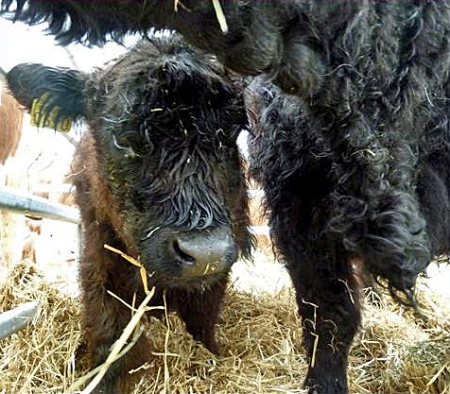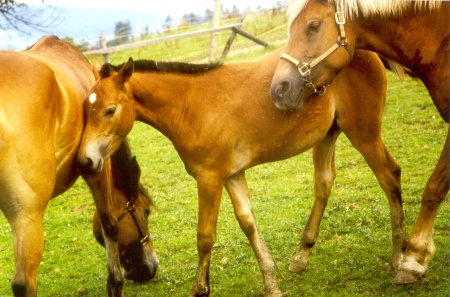 Recently I was in Denmark for an organic agriculture tour, perfectly organized by the Danske Foedevare og Landbrugsjournalister, takk skal i have!
Recently I was in Denmark for an organic agriculture tour, perfectly organized by the Danske Foedevare og Landbrugsjournalister, takk skal i have!
 Most impressive for somebody used to 20-hectare Swiss organic farms: The sheer size of it all. For example the visit at Axel Manssons. He produces vegetables on 1300 hectares (400 with organic production) and herds what’s soon to be 111’000 hens for organic eggproduction. Mansson started from scratch with 46 hectares in 1976. Now he is covering over 90% of Denmarks need of organic and conventional Iceberg-salad and big shares of other vegetables (see Homepage).
Most impressive for somebody used to 20-hectare Swiss organic farms: The sheer size of it all. For example the visit at Axel Manssons. He produces vegetables on 1300 hectares (400 with organic production) and herds what’s soon to be 111’000 hens for organic eggproduction. Mansson started from scratch with 46 hectares in 1976. Now he is covering over 90% of Denmarks need of organic and conventional Iceberg-salad and big shares of other vegetables (see Homepage).
 This is a good example for the organization of the danish sector: The national organic label Statsgarantered oekologisk is identical with the EU-Standards. They allow sectorial organic, meaning that not the whole farm has to work with organic production. It’s not possible though to grow organic and conventional in the same sector. Still, Mansson has found a way to cope with that hurdle: He has split up his Company in different subcompanies to separate organic from conventional.
This is a good example for the organization of the danish sector: The national organic label Statsgarantered oekologisk is identical with the EU-Standards. They allow sectorial organic, meaning that not the whole farm has to work with organic production. It’s not possible though to grow organic and conventional in the same sector. Still, Mansson has found a way to cope with that hurdle: He has split up his Company in different subcompanies to separate organic from conventional.
This flexible policy has helped the danish organic sector to quite a big share in the total food market: They hold around 8 percent. And the demand is still growing. Big, very big farmer-owned companies like Danish Crown and Arla, both dominating the meat and milk processing sector respectivly, want higher production.

 Starting with the milk sector, we visited Bo Kaczmarek and Asmus Asmussen, organic milk Producers with a shared stable in Roedekro, Jutland. They currently milk 180 Holstein Friesians with a production average of 10’500 kilos per cow and year. This is an awful lot for an organic cow, at least in Switzerland. But the solution of the riddle isn’t hard to find: 30 percent of the dry matter in the feeding ration are from concentrates. This is a further example of the laid backer rules in dansk organic: In Switzerland we have a 10-percent-limit for concentrate feeding. We asked Kaczmarek and Asmussen if it was an issue in Denmark and they said no.
Starting with the milk sector, we visited Bo Kaczmarek and Asmus Asmussen, organic milk Producers with a shared stable in Roedekro, Jutland. They currently milk 180 Holstein Friesians with a production average of 10’500 kilos per cow and year. This is an awful lot for an organic cow, at least in Switzerland. But the solution of the riddle isn’t hard to find: 30 percent of the dry matter in the feeding ration are from concentrates. This is a further example of the laid backer rules in dansk organic: In Switzerland we have a 10-percent-limit for concentrate feeding. We asked Kaczmarek and Asmussen if it was an issue in Denmark and they said no.
 Back to the milkmarket: Arla wants to expand it’s organic milk production by 25 to 30 percent until 2017 and it wants to launch more and more organic variants in most dairy product categories. The strategy is organic for the masses: „Make organic products accessible to all – they must be affordable, and we will ensure that the product quality meets the modern consumer demands“, Arla says in it’s Vision for organic dairy production. The organic premium has been rised recently by 2 Eurocents, but I haven’t found out what the effective milk Price is (working on it yet and will update)*. Anyway, good perspectives for our two farmers that produce for the milk giant. They want to add another 20 cows to their herd now. Arla is also a partner of the farmers in the yearly on-farm marketing event „oekodag“, that’s coordinated by the organic farmers union. This is the day, when danish Producers let their cows out for the first time of the year, and if you check this out you will understand why it’s called the cows spring party… Just that you don’t think that Arla is alone on the market. There is four main relatively small competitors: Thise, Naturmaelk (with the coolest logo of all times), Oellingegard and Them.
Back to the milkmarket: Arla wants to expand it’s organic milk production by 25 to 30 percent until 2017 and it wants to launch more and more organic variants in most dairy product categories. The strategy is organic for the masses: „Make organic products accessible to all – they must be affordable, and we will ensure that the product quality meets the modern consumer demands“, Arla says in it’s Vision for organic dairy production. The organic premium has been rised recently by 2 Eurocents, but I haven’t found out what the effective milk Price is (working on it yet and will update)*. Anyway, good perspectives for our two farmers that produce for the milk giant. They want to add another 20 cows to their herd now. Arla is also a partner of the farmers in the yearly on-farm marketing event „oekodag“, that’s coordinated by the organic farmers union. This is the day, when danish Producers let their cows out for the first time of the year, and if you check this out you will understand why it’s called the cows spring party… Just that you don’t think that Arla is alone on the market. There is four main relatively small competitors: Thise, Naturmaelk (with the coolest logo of all times), Oellingegard and Them.
 Let’s talk about meat: Another growth-willing processor is Friland, a daughter company of Danish Crown. They are trying to boost the production of free range pigs and Beef cattle, whereof about two thirds are organic at the moment. As in Switzerland, organic meat does not have a big share in the market, something between 2 and 5 percent of the market (as compared to eg. eggs at 17%). But as more and more consumers get fed up with the industrial production of meat, the demand for animalfriendlier produced meat is rising strongly. Stil it’s not easy to convince the well-doing conventional producers of a change, although Friland has recently rised the premium on the producer price to US$ 2.55 per kilo slaughtered. We visited one farmer who delivers about 4000 slaughter pigs a year to Friland. The system looked very good. Piglets are kept with their mothers for seven weeks in huts and on meadows and are from then on living in stables with open air areas and straw.
Let’s talk about meat: Another growth-willing processor is Friland, a daughter company of Danish Crown. They are trying to boost the production of free range pigs and Beef cattle, whereof about two thirds are organic at the moment. As in Switzerland, organic meat does not have a big share in the market, something between 2 and 5 percent of the market (as compared to eg. eggs at 17%). But as more and more consumers get fed up with the industrial production of meat, the demand for animalfriendlier produced meat is rising strongly. Stil it’s not easy to convince the well-doing conventional producers of a change, although Friland has recently rised the premium on the producer price to US$ 2.55 per kilo slaughtered. We visited one farmer who delivers about 4000 slaughter pigs a year to Friland. The system looked very good. Piglets are kept with their mothers for seven weeks in huts and on meadows and are from then on living in stables with open air areas and straw.
Here comes a Little disclaimer: Arla and Friland were both sponsors of the journalist tour. Both companies are huge with all the problems that come with it. But notwithstanding I think they are more conscious about their roots (farmer-ownership) than some of the similar companies in Switzerland. Anyway no exaggerated praise, because growth and size matter, but it’s not the only way to go.
 Best example for a different Approach on the trip was Skaertoft Moelle, farm with only 50 hectares, while the average danish organic farmer has almost 100. But the difference is, that the Bonde family have their own mill, where they produce 40 different kinds of flour. Plus a show bakery/kitchen where daughter Marie Louise Bonde teaches an urban crowd (that is feed up with industry bread) how to make their own bakingspecialities. She’s also very active on Instagram. A nice example for vertical Integration of the production chain with a combination of farm and small processing unit.
Best example for a different Approach on the trip was Skaertoft Moelle, farm with only 50 hectares, while the average danish organic farmer has almost 100. But the difference is, that the Bonde family have their own mill, where they produce 40 different kinds of flour. Plus a show bakery/kitchen where daughter Marie Louise Bonde teaches an urban crowd (that is feed up with industry bread) how to make their own bakingspecialities. She’s also very active on Instagram. A nice example for vertical Integration of the production chain with a combination of farm and small processing unit.  The Bondes are selling their flour to all of the major retailers in Denmark, who are ready to pay a higher price for a handicraft flour that has better taste, quality and fancier packaging than industrial products. A model that should be applied more often in agriculture, be it organic or conventional, but naturally rather organic.
The Bondes are selling their flour to all of the major retailers in Denmark, who are ready to pay a higher price for a handicraft flour that has better taste, quality and fancier packaging than industrial products. A model that should be applied more often in agriculture, be it organic or conventional, but naturally rather organic.
*PS. Update concerning milk Price: „Arla milk Price for kg of organic milk is 3,19 kr. (43 Euro Cent) of which 0,69 kr (9 Euro Cent) is organic Premium. Price includes expected Premium at the end of the year“, writes my danish colleague Lars Frederik Thalbitzer. The current Arla Milkprice is available here. Thanks a lot for your help, Lars Frederik!
More english posts in the respective category.





















